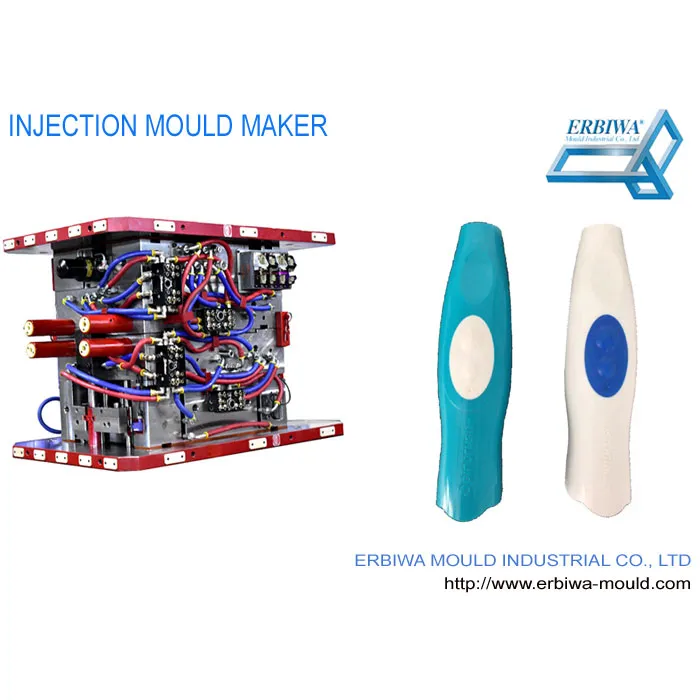Characteristics of Multi-cavities 2K Injection Mold
2024-07-28
A multi-cavity 2K (two-shot) injection mold is an advanced mold used in injection molding processes to produce parts with multiple cavities and the ability to perform two separate injection stages. This type of mold is used to create complex and multi-material parts efficiently. Here’s a detailed overview of its characteristics:
1. Design and Construction
- Multi-Cavity: Incorporates multiple cavities within a single mold to produce several parts in one cycle. This increases productivity and efficiency by reducing cycle times and material waste.
- Two-Shot (2K): Capable of performing two separate injection stages within the same mold. This allows for the production of parts with different materials or colors in a single molding process.
- Material Compatibility: Designed to handle different types of plastics or elastomers. The first shot may use one material, while the second shot uses a different material.
2. Injection Process
- Dual Injection Stages: The mold has mechanisms to inject two different materials sequentially. The first material is injected and allowed to partially or fully solidify, and then the second material is injected to bond with the first material or create a two-tone effect.
- Rotary Mechanism: Many 2K molds use a rotary mechanism to rotate the mold or the part between injection stages. This ensures accurate alignment and proper bonding of the two materials.
3. Complexity and Precision
- High Precision: Requires precise engineering and manufacturing to ensure accurate alignment of cavities and proper material bonding.
- Complex Design: Often involves complex mold design, including alignment pins, retractable cores, and sophisticated cooling systems to handle the dual injection process.
4. Material Handling
- Multi-Material Injection: Capable of processing different materials such as hard and soft plastics, or materials with different colors, in a single mold.
- Adhesion and Bonding: Designed to ensure proper adhesion between different materials, which may involve specific mold temperatures and pressures.
5. Mold Components
- Cavities: Multiple cavities within the mold can produce multiple parts simultaneously. The number of cavities can vary depending on the mold design and the part size.
- Core and Cavity Inserts: Can be customized to accommodate different part geometries and features.
- Cooling Channels: Integrated cooling systems to manage the temperature of the mold and ensure uniform cooling of the parts.
6. Production Efficiency
- Reduced Cycle Time: By producing multiple parts in one cycle and combining two injection stages, the mold reduces overall production time and increases output.
- Material Efficiency: Minimizes material waste and reduces the need for secondary operations, such as painting or assembly.
7. Applications
- Automotive Parts: Used to manufacture complex automotive components with multiple materials, such as dashboard assemblies or trim parts.
- Consumer Goods: Ideal for producing items like toothbrushes with soft and hard components or multi-color kitchen tools.
- Medical Devices: Used in the production of medical devices that require both rigid and flexible parts in a single piece.
8. Maintenance and Care
- Regular Inspection: Requires regular inspection and maintenance to ensure proper function and to address any wear or damage.
- Cleaning: Needs thorough cleaning between production runs to prevent material cross-contamination and ensure product quality.
9. Cost and Investment
- High Initial Cost: The design and manufacturing of multi-cavity 2K molds involve significant initial investment due to their complexity and precision requirements.
- Long-Term Savings: The high upfront cost is often offset by the increased production efficiency and reduced per-unit cost in high-volume production.
10. Design Considerations
- Mold Design: Requires careful consideration of the mold design to ensure proper material flow, cooling, and alignment. Complex design may involve simulation and prototyping.
- Material Compatibility: Selecting compatible materials that adhere well together and perform as required in the final product.
11. Environmental and Regulatory Factors
- Compliance: Must comply with industry standards and regulations, particularly in sensitive applications like medical devices or automotive components.
- Environmental Impact: Designed to be efficient in material usage, which can contribute to reduced environmental impact compared to other manufacturing methods.
Summary
Multi-cavity 2K injection molds are advanced tools designed to enhance the efficiency and versatility of the injection molding process. They are used to produce high-quality, multi-material parts with complex geometries, offering significant advantages in terms of production speed, cost-efficiency, and material use. Proper design, maintenance, and operation are crucial to maximizing the benefits of these molds.



